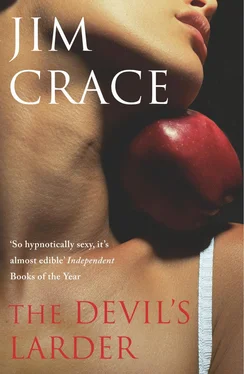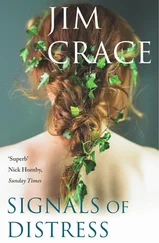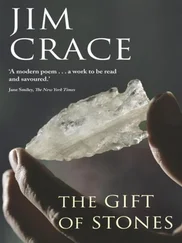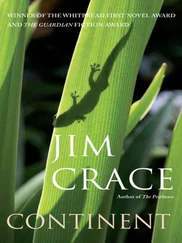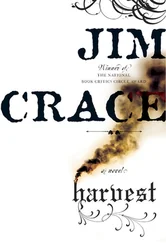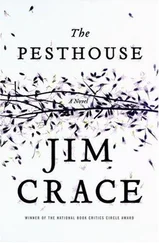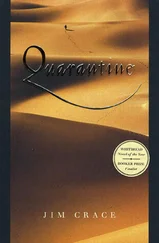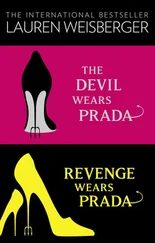The diggers finally came with dogs to hunt for bodies. Who could survive that long and in that heat with nothing to sustain them? But when they pulled the rubble and the rocks away and peered between the ceiling beams they saw at once how hale the couple seemed, sustained in their hot tent. Each had a flat stone on the abdomen, as if their bodies would have drifted off, would have risen through the earth and rubble, as sinuous and weightless as a plume of smoke, without the anchoring of stones.
‘You can’t eat stones,’ the farmers always said when crops were poor or prices low. But, when my neighbours had been rescued from the slip, wise heads explained what everybody always knew, that there was sustenance in rock and earth, that those grey stones had fed the couple, by paying for their body heat with food.
And so, those nine years down the line, when the old man had to put his wife into the ground for good, he did not send her off clutching family photographs or her best brooch or something gold to bribe the gods or (as is often done) put cobs of maize into her hands to feed her in the afterlife. Instead, he placed one of the flat grey stones that had once saved her life across her abdomen and wrapped her fingers round its rim. The stone, he thought, might return its heat to her and once again might sweat its nutrients and minerals, its energies, onto her skin, to be absorbed, to keep her warm and hale and fed until the rubble and the clay backed off, replaced the roof, restored the rear wall to their lives, returned uphill from whence it came.
‘THE FINEST FOOD, like the best of marriages, is bound to break the rules,’ according to Eugene Naval. ‘It seeks to reconcile opposing tastes and textures, sweet with sour, hot with cold, sharp with bland, the fluid and the firm, the solemn and the comic, and it depends as much on luck as diligence.’
So the tiny Syrian who, when we were kids, used to run the fried-food stall down by the harbour esplanade was working in the best traditions of his craft when — by way of cleaning up and as a joke aimed only at himself — he made a meal of his remaining scraps one afternoon, combining the last fish on his tray and a sorry piece of lamb’s liver with the one surviving wheel of pineapple. He frittered the lot in sesame oil, wrapped it in a leftover sour pancake, added a dash of unsold onion relish and a dramatic shake of Boulevard Cream Liqueur from his near-empty bottles, and garnished everything with hyssop leaves.
He would have tested it himself, then tossed it to the gulls, had not the seminary tutor come cycling by and, tempted by the new and usual smells, stopped off for an unscheduled snack.
‘I’m closing up. There’s nothing left,’ the Syrian explained, but the tutor could see for himself that this was not entirely true. He bought the pancake full of scraps — a melange which as yet had not been named — described its smell as ‘heavenly’, donated a copy of the most recent Seminarian , of which he was the proud editor, and rode off on his bike.
Depending on your viewpoint, the tutor tumbled off his bike that afternoon, fifty metres from the Syrian, either because the pioneering snack was so fabulously delicious, or because it was too shockingly extravagant for one who earned a living advocating moderation and austerity. It’s possible, of course, that he simply lost balance, fell and stunned himself. It couldn’t have been easy for a man of his age and weight, and with so many people strolling on the esplanade, to grip the handlebars and eat his pancake at the same time.
What is certain is that the Syrian, delighted at the impact he had made on someone of another faith and size, incorporated this new pancake meal of liver, fish and pineapple into his regular menu. The passengers from visiting liners took word of it back to their chefs at home, and it appeared in restaurants and cookery books from that time on.
So even though the Syrian never became rich or famous, he made a lasting contribution to international cuisine. But only he — and those of us out walking near the harbour on that afternoon in 1969 — can say with any certainty why this distinguished snack is known throughout the world as ‘tutor on two wheels’ and, incidentally, why the proud seminarian himself was from that day onwards feted as ‘the Pancake’.
WHAT COULD BE a better wedding gift for two dear friends? A newly germinated love-leaf tree for the glassed-in balcony of their first apartment. It was, in fact, a sort of palm, Roystonea labia . We did not know whether they were green-fingered but, never mind, they’d have to care for it. The label in the pot described our gift as ‘edible, low-maintenance and with a modest habit, 2 metres at ten years’. What caught our eye, though, were the claims made by the sales leaflet that came with every purchase. It said:
The inner meat, shoots and tender terminal buds of the lip palm, or love-leaf tree, from Madagascar can be harvested as a vegetable and eaten as a dressed salad or with rice-and-pork dishes. Tradition forbids the picking of the foliage before or after the palm’s seventh birthday. Shoots of a seven-year-old plant, also known as heart of palm, palmetto d’or or millionaire’s salad, are, however, thought to bring good fortune and rejuvenation to their consumers and are regarded as potent aphrodisiacs.
With this growing gift, then, we’d plant a time bomb in their marriage. Here was a loving meal, seven years in preparation, to whet their appetites.
The lip palm flourished on their balcony. We checked whenever we went round, that first year of their marriage. The leaves were glossy and unpicked, the soil was damp, the plant was growing up. We envied them the hungry years ahead. We were aroused ourselves, just at the prospect of the harvest on their seventh anniversary.
IT IS A MIRACLE they’ve stayed together for so long. They’ve both got other friends and lovers. We never see them in each other’s company, not even in the shops or at the railings of the school. Their love was so shortlived. There was no heart to it. It has to be the little girl — she’s six this year — that stops them splitting up.
We went round to their place about a week ago, to babysit. Their daughter was asleep by nine. We must both have had the same thing on our mind. We’d done our sums. The lip palm was seven. We went out onto their balcony like thieves, armed with a kitchen knife. I think it was a shock, a disappointment, too, to find the centre of their tree removed. They must have cut and eaten the meat, we guessed — too good to waste — and gone off in their separate cars to spend their resurrected passions with more recent friends.
We managed to cut out what remained of the freshest shoots and foliage. We did not bother with the salad dressing or the pork and rice. We ate palmetto, on the balcony, like chocolate. How good it was! How young we felt as, with their daughter sleeping in a distant room, we did what two dear friends should do when they have passed their seventh, loving year.
IT’S SAID THAT cheese is milk that has grown up, fresh milk transformed by time. If so, then what is boysie tart? A senile dish, turned bitter by the years? It’s made from old blue cheese, matured — ignored — enough to be as hard and slippery as a horse’s hoof.
The cheese is difficult, too gnarled to cut easily. You can only chisel and pare it into hard slivers, the devil’s nail clippings. It won’t be edible until you’ve baked it with sultanas, prunes and well-hung game — a scrub fowl’s best — in a sourdough case. Old cheese, old fruit, old yeast, old meat. All carcasses. For New Year’s Eve, the last meal of the dying year.
Читать дальше
